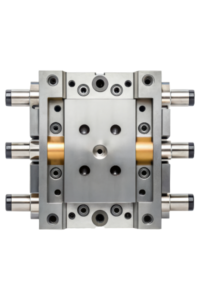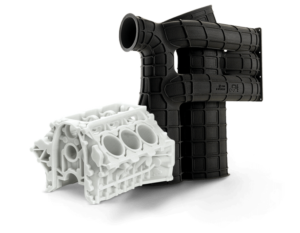Rapid prototyping with 3D SLS printing
We are living in a fast-paced manufacturing world, where rapid prototyping has become important for bringing innovative ideas to life. Among the different 3D printing technologies available, Selective Laser Sintering (SLS) evolved as one of the most reliable methods for producing high-quality prototypes with exceptional accuracy and durability. No matter your industry— automotive, consumer goods, or healthcare—SLS printing provides unmatched value for rapid prototyping and product development.
This blog explores how SLS is revolutionizing the process of prototyping rapidly, highlights its key advantages, and explains why manufacturers are increasingly adopting this technology to elevate their designs. .
What is SLS 3D printing?
Selective Laser Sintering or SLS is an advanced 3D printing technology that utilizes a high-powered laser to fuse powdered material into solid structure, layer by layer. Unlike many other 3D printing technologies, SLS does not need support structures, allowing for complex and intricate geometries without compromising strength and accuracy. This makes it a perfect solution for prototyping and low-volume production.
SLS 3D printing is widely utilized in industries that need functional and robust prototypes, as it delivers high precision, excellent mechanical properties and a broad range of material options including engineering-grade plastics like nylon.
Advantages of rapid prototyping with SLS 3D printing
- Speed and efficiency
One of the largest benefits of SLS 3D printing for rapid prototyping is the speed at which functional parts can be produced. Traditional manufacturing processes such as CNC machining and injection molding include complex tooling that can take weeks or even months to develop. With SLS, manufacturers can move from concept to physical prototype in a matter of days, allowing faster iteration and shorter product development cycles.
- Complex geometries and design freedom
SLS printing allows for the making of highly complex geometries that may be impossible or too expensive to achieve utilizing traditional manufacturing methods. The ability to produce intricate internal structures, lightweight lattice designs and organic shapes provides engineers with unlimited design freedom, leading to optimized, high-performance components.
- Superior mechanical properties
Prototypes made using SLS are not just accurate, they also have excellent mechanical strength and durability. SLS-printed parts can withstand real-world testing conditions, making them perfect for functional prototypes and end-use applications. Materials used in SLS printing, for example nylon, offer high resistance wear, heat and impact, ensuring prototypes perform reliably under demanding situations.
- Cost-effective prototypes
SLS printing eliminatesthe need for costly tooling and molds, significantly reducing prototyping costs. Since it is an additive manufacturing process, there is minimal material waste, making it an economical solution for businesses looking to develop andtest multiple iterations of a design without incurring high expenses.
- Versatile material selection
SLS offers a wide range of materials, including high-performance polymers like Nylon 11, Nylon 12 and reinforced composites. These materials provide excellent strength, flexibility and chemical resistance, making them suitable for a variety ofindustries, including medical, consumer electronics and automotive.
- Scalability for low-volume production
Beyond prototyping, SLS printing is also an excellent solution for low-volume production runs. Since the process does not require molds or tooling, businesses can manufacture small batches of customized parts cost-effectively. This is uniquely valuable for companies and startups exploring market validation before committing large-scale production.
Industries benefiting from SLS rapid prototyping
Automotive
SLS printing is widely utilized in the automotive industry for producing operational prototypes, customized components and lightweight structural parts. Engineers can quickly test aerodynamics, fit and performance before committing to final production.
Aerospace
With stringent quality and performance standards, the aerospace industry greatly benefits from SLS 3Dprinted prototypes. This technology allows for the designing of lightweight yet durable components that meet industry regulations.
Healthcare & medical devices
Medical device manufacturers leverage SLS printing to make patient-specific prosthetics, durable medical tools and surgical guides. This technology allows rapid customization while maintaining biocompatibility and high precision.
Consumer goods and electronics
From wearable technology to home appliances, SLS allows manufacturers to produce innovative products with increased ergonomics, functionality and aesthetics. Companies can rapidly iterate designs based on user feedback, further enhancing product development.
Why choose SLS 3D printing for rapid prototyping?
Businesses that infuse SLS printing into their prototyping workflows get a competitive edge by reducing prototyping costs, accelerating product development and improving overall performance of the product. The ability to quickly produce high-strength, complex parts empowers companies to refine designs and streamline product development with greater efficiency.
By leveraging SLS technology, businesses can:
- Speed up design iteration and testing phases
- Develop functional prototypes with end-use mechanical properties
- Reduce material waste and production costs
- Create intricate geometries without support structures
- Scale up for small-batch production without additional tooling costs
FAQs
Q1: What materials can be used in SLS 3D printing? A1: Numerous engineering-grade materials with superior strength, flexibility, and heat resistance are compatible with SLS printing, such as Nylon 12, Nylon 11, thermoplastic elastomers, and reinforced composites.
Q2: How fast can I get a prototype using SLS printing? A2: SLS printing can produce functional prototypes in just a few days, depending on how complicated the design is, greatly speeding up the time it takes to develop new products.
Q3: Is SLS printing suitable for end-use production? A3: Yes, SLS printing is frequently used for customized parts and low-volume production runs due toits accuracy, durability, and affordability, often outperforming traditional manufacturing methods..
Q4: How does SLS printing compare to other 3D printing technologies? A4: SLS is perfect for functional prototypes and industrial applications since it doesn’t require support structures like FDM and SLA, enabling more complicated geometries and better mechanical qualities.
By leveraging SLS for rapid prototyping, businesses can drive innovation, enhance efficiency, and go to market faster. Ready to accelerate your product development? Connect with a Quickparts expert today.
Reference:


